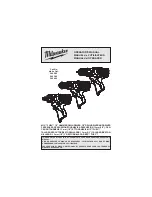
½ Max Movement
A good rule of thumb is, the smaller the hole or depth of cut, and the softer the
material to be machined etc, the faster the speed. To adjust the speed proceed as
follows. 12 Speeds are possible, (see Fig. 4)
1. Turn the machine OFF and isolate from the main supply to prevent accidental starting.
2. Loosen screw (130) and remove the pillar cap (129), store safely.
3. Raise the milling head until the pillar (132) is flush with the top cover (2).
4. Open the belt drive cover by releasing the two catches (14), and lift open the cover.
(safety switch should operate to prevent accidental starting).
5. Loosen the locking screw (46), pull the motor (33) inwards to slacken the V belt (29),
remove the belt and store safely.
6. V belt (21) can now be repositioned to desired location.
7. Refit V belt (29), refer to table Fig. 4 for correct position.
8. Tension V belts by pushing motor
outwards, if necessary, a
screwdriver or similar can be
used as a lever between the
head box (47), and the motor
mount (40).
DO NOT apply excessive pressure.
See Fig. 5 for correct adjustment.
9. Close the top cover and secure with latches.
Ensure the cutter is not making contact with the work piece, turn the machine ON.
Slowly bring the cutter into contact with the work piece and start machining.
DO NOT attempt to make too bigger cuts than the cutter and machine are capable
of, it is much better and safer to make several small passes.
Always use an appropriate cutting/cooling fluid whilst machining, which can be
applied with a small brush etc, NOT FINGERS.
DO NOT allow swarf to build up in the cutting area. Stop the machine and remove
using a suitable implement, (brush etc).
When finished turn the machine OFF, return the cutter to the uppermost position and
allow it to come to a complete stop before attempting to remove the work piece or
tool etc. Also to prevent accidental starting, isolate the machine from the power
supply by turning off at the wall socket and removing the plug from the socket.
Always finish by cleaning the machine down and storing all tools etc away safely.
There are two possibilities when drilling, course and fine feed.
To use the course feed, loosen the feed knob (86) and operate by pulling the handle (84
& 85) at the desired rate.
For fine feed, tighten the feed knob, and operate the fine feed wheel (95) at the desired
rate.
IMPORTANT When milling, ONLY the fine feed option may be used.
Fig. 5
CHUCK & OR MILLING CUTTER REMOVAL/REPLACEMENT
1. Ensure the machine is switched OFF and isolated from the main electric supply.
2. Open the top cover as for speed changing.
3. Hold the chuck/cutter firmly using industrial work gloves or similar.
4. Loosen and unscrew the draw bolt (4) approx two full turns.
5. Firmly strike the top of the draw bolt with a soft faced mallet, (NOT Hammer). The
Chuck/cutter should drop slightly, holding the chuck/cutter with one hand unscrew
fully the draw bolt with the other hand and remove the chuck/cutter.
Fit replacement in reverse order.
To fit MT3 -MT2 drill sleeve, the draw bolt must be removed completely and stored safely.
Fit arbor by inserting the taper shank into the spindle, turn the arbor whilst doing so to
locate the drive key into the slot.
To remove it when finished, lower the spindle by either operating the course drilling handles
or by turning the fine feed handwheel to lower the spindle and expose the drift slots.
Turn the spindle etc to locate the slots in the spindle and arbor.
Insert the drift (108) into the slot, again apply a firm but swift blow to the drift, using a
hammer.
Using suitable hand protection, catch the arbor as it falls, remove the drift and store
safely.
SPINDLE RETURN SPRING
It shouldnt normally be necessary to make adjustments to the return spring pressure, in
the event it does become necessary EXTREME CAUTION should be observed.
To carry out this adjustment proceed as follows:
1. Ensure the spindle is as high as it will go, lock in position with the spindle locking lever (72)
2. Loosen the Knob (61) three or four full turns, DO NOT remove completely.
3. Firmly grip the spring cap (64), preferably wearing heavy duty work gloves, carefully
take up the tension by turning very slightly anticlockwise, pull the cap away from the
mill head to disengage the locating pawls, DO NOT let go as the spring will unwind at
speed and force causing damage and or personal injury.
4. Turn the cap anticlockwise to increase the spring tension, when the required tension
is reached, push the cap back towards the head and relocate the pawls.
5. Whilst continuing to hold the cap in position, tighten the knob (61).
6. Test the action of the spindle return, and repeat the above if more tension is required.
NOTE: Check periodically the knob (61) is always tight, if it does become loose during
normal use, carefully remove the knob, taking care not to allow the spring cap to move,
apply thread lock to the knob thread and refit to machine.
-
11
-
-
12
-
Summary of Contents for Metalworker CMD1225C
Page 2: ...22 1...






























